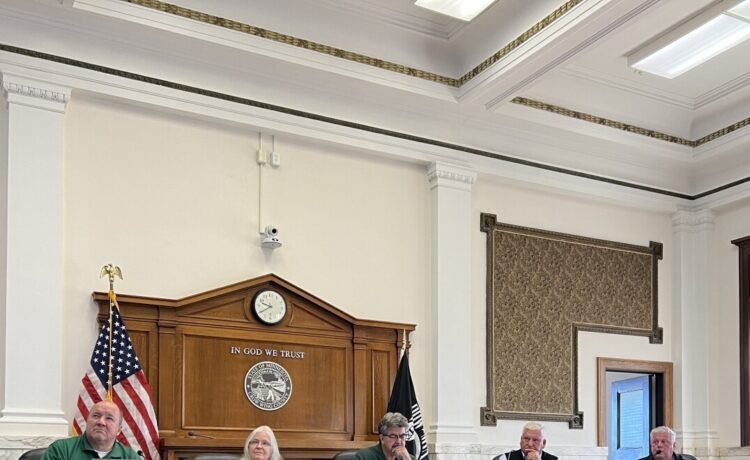BRAINERD — Following funding requests, Crow Wing County commissioners tabled action on a recommendation to use opioid settlement dollars for ongoing expenses with the sheriff’s department, particularly expenses with the jail.
The funds are from the
with the state of Minnesota. In 2022, Crow Wing County learned it would receive over $2.5 million over the next 18 years to combat the opioid epidemic.
When the Brainerd Lakes Area Drug Education Opioid Coalition met on July 26, it discussed funding requests and approved those by the Brainerd Fire Department, the sheriff’s office and Bridges of Hope to keep the warming shelter open year-round.
All together, those requests amounted to $344,597.37 — with $8,000 divided over two years for the fire department, $100,000 to the sheriff’s office to help fund the jail medical program, $9,288.37 to replace medication carts at the county jail, $19,309 for the sheriff’s Lakes Area Drug Investigative Division with most of that going to pay insurance and a smaller part for a secure storage drive and finally $200,000 for Bridges of Hope divided over two years for the Bridges on 7th Warming Shelter to remain open year-round.
Kara Terry, the county’s Community Services director, presented the coalition’s recommendations to the County Board Tuesday, Aug. 13.
I just don’t think the stew was cooked on this yet.
Commissioner Paul Koering
The board approved one funding request from the list of $8,000 per year for the Brainerd Fire Department to fund a PulsePoint subscription for two years. PulsePoint is a nonprofit. Its app alerts CPR-trained people to someone who is having a sudden cardiac arrest nearby. The idea is to link people who are trained in CPR to someone in need quickly. Terry said all Crow Wing County first responders are part of it and the Brainerd Fire Department uses PulsePoint.
“They would like to use it, not only for the CPR notification, but to push out opioid education. So education on opioid overdoses, for example,” Terry said.
Commissioners asked for clarity that the money would fund notification to all trained first responders in the county and after receiving that, voted to approve the funding request.
The other requests met more resistance as commissioners questioned whether that met the true design of the opioid settlement and whether the items the sheriff’s office was seeking funding for shouldn’t be considered as operational costs for the regular budget.
Initially, the jail brought forward funding its entire medical program using the opioid dollars. The coalition noted the grant would be a one-time funding source so funding the whole program for one year may not be the best use of those dollars, Terry said. She noted they are also trying to be mindful the money is designed to provide funding over the next 15 years or so and they are unsure of what dollars they will receive going forward.
“You’re telling us now that you feel like this falls into the parameters of what we’re supposed to be spending the opioid dollars on,” Commissioner Paul Koering asked as he sought confirmation for the record in case an auditor questions the use.
“So two things to your question, commissioner, the opioid coalition believes it falls under the basket. I do not believe it’s a good use of opioid dollars, but I’m not the overall keeper of the opioid dollars,” Terry said. “The coalition makes those decisions. I think it’s a, it’s money going towards the budget for a one-time use. And I don’t think that’s a good use. So do I personally agree with it? No. Does the coalition think it is a good use of dollars? Yes.”
Sheriff Eric Klang said they have the coalition in place to make those decisions.
“So the coalition made the decision that it’s a good use, and I agree 100% with that,” Klang said.
Commissioner Steve Barrows said he struggled with having a medical program in the jail for a long time that has always been funded by the levy.
“And so I’m wondering why, all of a sudden, we would need an additional $100,000 to support this program if you can explain that to me,” Barrows said, asking Klang for the details. Klang said he wasn’t at the meeting.
Terry replied the request came to fund the full jail medical program and since the jail program has to be funded and has been funded regardless, the coalition decided it could fund $100,000 of the jail medical program but not the full ask. Barrows pressed questioning if those dollars weren’t already part of the budget.
Terry said they were looking to offset jail medical expenses for 2025. Barrows asked if that discussion shouldn’t be part of the levy negotiation that takes place instead. Terry said it could be if that’s the board direction but this request was brought forward via the opioid coalition by Chief Deputy Andy Bradley for consideration.
“I’m just questioning, why, when we already have a budget, we know we have to supply that medical program over there, why, all of a sudden, we would look at this pot of money, the opioid dollars, as a resource to fund something that we’ve always funded through our levy process?” Barrows said.
Administrator Deborah Erickson said she thought they were looking at creative ways to help offset the reduced revenue from the jail. This year,
Cass County terminated its longstanding contract i
n place since the jail was constructed in 2007 to house prisoners at the Crow Wing County Jail creating a $1 million shortfall.
“Obviously, we had some reduced expenses that were already incurred with closing of the two pods there for 2025, the sheriff’s office has been looking to try to find ways to help either boost revenues or reduce expenses,” Erickson said. “Is this a way to reduce expense and boost revenue? You could look at it that way.”
The Crow Wing County Jail has five housing units or pods in its 78,000-square-foot facility. Erickson said she shared Barrows’ concern of using the dollars as a one-time infusion of money to fill the gap in 2025, which means in 2026 they’d be back in a situation of needing to find that money.
“So it is a Band-Aid fix, and I think it would be something that should be looked at in context of the full budget proposal that’s being brought to the County Board for them to consider,” Erickson said, noting it could be a stop-gap but when the funding goes away, the county has $200,000 it has to find for 2026.
Koering said he understood the opioid dollars would be helping people get into recovery and that type of use, but the jail funding doesn’t seem to fall into that basket. Klang said it does come into play for those in the jail who are addicted and in line for medications. Klang said it involved the whole cell block.
Terry said opioid dollars are for prevention, assisting in training, to help with kids and families and adults struggling with addiction and its treatment so there are not a lot of restrictive rules. Terry said the jail is trying to do things to help people facing addiction and substance misuse.
“But where I struggle with it is because it’s a one-time funding source for an ongoing budgeted need,” Terry said. “That’s where I don’t think that’s the best use of opioid dollars.”
Koering, who said he didn’t know he was on the coalition, said he sees he should bring his strong personality and voice of reason there.
“I just don’t think the stew was cooked on this yet,” Koering said, asking if action was needed that day. “I think if you go back, come back and give me some more reasons why, I probably could get there. But I’m not convinced today, so I somehow, I think it needs to have a little more cooking.”
Commissioners Doug Houge and Jon Lubke also raised questions on funding and the medical cart. Barrows said he was inclined to remove the items from the sheriff’s department and the Bridges of Hope request as Brainerd has not approved the shelter for year-round use. The board expects to hear from the sheriff’s department and Bridges of Hope at a future meeting. The county is also working on creating a dashboard so the public can see where the dollars are being allocated.
“This is a bigger issue, because this creates more of a problem in the budget in the future down the road,” Koering said. “So I think it needs to be flushed out more at senior management, and flushed out more if it meets in line with the opioid settlement.”
Funding areas identified by the BLADE/Opioid Coalition
On the county’s website, the BLADE/Opioid Coalition is identified and a description given of funding opportunities via grants to community members or organizations to advance three strategic areas outlined below.
“The BLADE/Opioid Coalition invites community members/agencies to advance collaborative, community-based work through a funding opportunity that will impact one or more of the following strategies:
- Expand capacity of programs targeting families impacted by substance use disorder with a focus on increasing reunification rates and safe placement options, or providing focused education and outreach for children in foster care whose primary reason for placement is parental substance use.
- Funding and support for schools to be trained on implementation of curriculum such as Adverse Childhood Experiences (ACEs), Healthy, Positive Outcomes, Substance Use Disorders, and Positive Community Norms; or integrate targeted outreach within existing school departments focused on high-risk priority groups and vulnerable families.
- Integration and strengthening of services and treatment of substance use disorder, mental health and primary care throughout the criminal justice system.”
Applicants are asked to include what they hope to achieve, how they will engage the community and how the proposal will advance the work of reducing the impact of opioids and other substances in the community.
Renee Richardson, managing editor, may be reached at 218-855-5852 or renee.richardson@brainerddispatch.com. Follow on Twitter @DispatchBizBuzz.

















